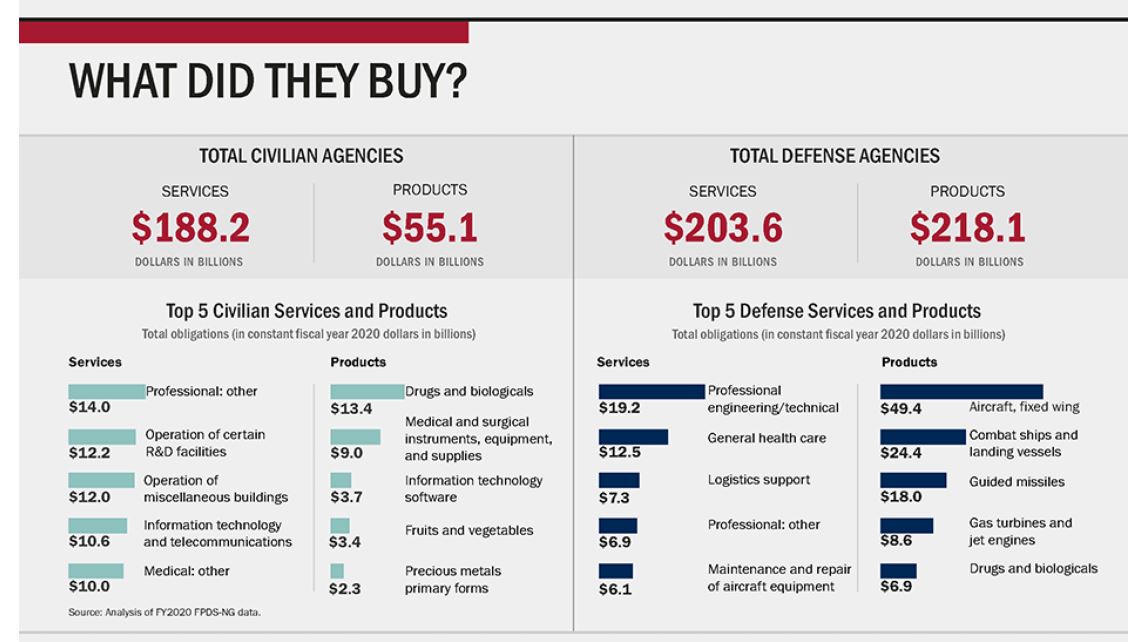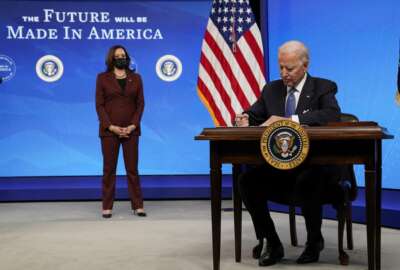Agencies on the hook to meet new Buy American acquisition goals for most products
OMB is releasing an advanced notice of proposed rulemaking today that, among other things, raises the percentage of component parts required to be manufactured in...
A new advanced notice of proposed rulemaking aims to make the most significant changes to the Buy American Act in almost 70 years.
The Office of Management and Budget is releasing the proposed rule today that, among other things, raises the percentage of component parts required to be manufactured in the U.S. in products that agencies buy. OMB said the increase will go from 55% to 60% immediately. It will then increase again to 65% by 2024 and 75% by 2029.
“The phased increase will allow small and large contractors time to transition their supply chain to domestic suppliers and to increase the use of American made components,” said a senior administration official during a call with reporters Tuesday night. “It also creates a temporary fallback threshold to maximize domestic content in procurement and prevent the issuance of more waivers to buy American while domestic manufacturers transition to more domestically produced component parts. The fallback threshold will allow a U.S.-made good with more than 55% U.S. content to receive a price preference only when no U.S. supplier can meet the increased threshold. The fallback threshold will be eliminated once the 75% threshold has gone into effect.”
The official said the proposed rule changes the content threshold, but it does not change the current application of the federal acquisition rules.
“For instance, on a finished product, the bar specifies how you count the components by value and what is excluded, which is things like the labor on the final assembly stage. So there’s no proposal to change what’s counted or how it’s counted, just to increase the threshold,” the official added.
Price preference part of incentives
The advanced notice of proposed rulemaking also ensures critical products and components in strategic industries will receive enhanced preferences under federal procurement rules. How much of a price preference is unclear. For example, for decades the Defense Department gave small disadvantaged businesses a 5% price preference on certain contracts.
The senior administration official said the third part of the advanced notice will increase transparency and accountability of compliance with the law through new reporting requirements for specific products and components, such as health care and semiconductors.
“As the pandemic demonstrated all too painfully, disruptions in the supply chain for critical products from semiconductors to medical supplies hurt our health, our national security and our economic security. There are clearly supply chain challenges now that this administration has been aggressively trying to help the private sector solve for those challenges, including doing a lot of coordination work,” the official said. “But in addition to that, we know that we need to also plan for the long run. We support the chipset, for example, and the president included funding for it in the American Jobs Plan. You’ll probably have noticed that it was also part of the US Innovation Competition Act that passed the Senate. We know that long term investments are also going to be needed to prevent supply chain disruptions in the future.”
And of course, the government purchases more than $600 billion a year worth of goods and services and the Biden administration wants to use the power of the purse to influence manufacturers and spur the market. The Biden effort follows similar ones by the Trump administration and previous ones that tried to increase the percentage of American-made products agencies bought. It’s unclear how impactful these previous efforts were as the data is self-reported by contractors.
“The spirit part of this rule that’s going to be proposed [Wednesday] is using federal purchasing power where we have clear supply chain weaknesses to bolster demand in domestic market, which is something that has a long history in the U.S., including around semiconductors,” the official said.
Commercial IT remains exempt
The notice of proposed rulemaking follows President Joe Biden’s Buy American executive order from January and OMB’s implementation policy from June.
The notice will be out for comment for 60 days and then OMB will go through the normal review and final rule process.
The Buy American Act doesn’t currently apply to commercial technology purchases. But the EO does require the Federal Acquisition Regulations Council to “promptly review existing constraints on the extension of the requirements in Made in America Laws to information technology that is a commercial item and shall develop recommendations for lifting these constraints to further promote the policy…”
The senior administration official said the White House believes the notice of proposed rulemaking is both aggressive and doable for agencies.
“This proposed rule reflects a months long, rigorous interagency policy process and over a dozen roundtables with business associations, small businesses and labor unions,” the official said. “It sets a new direction for enforcement of the Buy American Act. It marks just the first set of proposed reforms of procurement policy under the Biden Harris administration to ensure taxpayer dollars help American businesses compete in strategic industries and help America’s workers thrive.”
Another senior administration official elaborated on the effort that went into the development of the notice. The official said OMB led a “180-day interagency process, pulling together experts in the acquisition workforce across agencies, including the Department of Defense, which is the largest purchaser in the federal government. They all agreed that this will be a viable rule and that they thought that they could meet it. That’s part of also what gives us confidence in this rule. We designed it so that we give contractors time to adjust. But we’re also setting a high standard and the typical standard that our acquisition community thinks it’s totally reasonable.”
The first administration official said OMB also will go through a similar effort to look at service contracting and determine how to implement the EO in this area, in which the government spends more than on products.

To address the challenges that will inevitably come with increasing Buy American requirements, OMB said the Small Business Administration, the Food and Drug Administration, the Energy Department, the General Services Administration and several other agencies are already supporting this effort.
SBA, for instance, set up a new manufacturing office to help small manufacturers access contracts, financing and business development support. The White House said the office will coordinate activities across the agency in response to the President’s executive orders on Made-in-America, supply chain resiliency and racial equity.
GSA worked with 8(a) small businesses to procure energy efficient technologies for federal facilities as part of its Green Proving Ground program, which tests emerging technologies at federal facilities in order to help them scale and become viable in the market.
And the Defense Department “funded prototypes to sustainably source critical minerals and to create a new training hub with the Energy Department to increase the productivity of the U.S. machine tool base.”
Copyright © 2025 Federal News Network. All rights reserved. This website is not intended for users located within the European Economic Area.
Jason Miller is executive editor of Federal News Network and directs news coverage on the people, policy and programs of the federal government.
Follow @jmillerWFED






